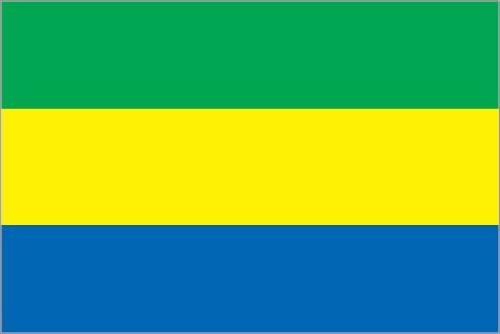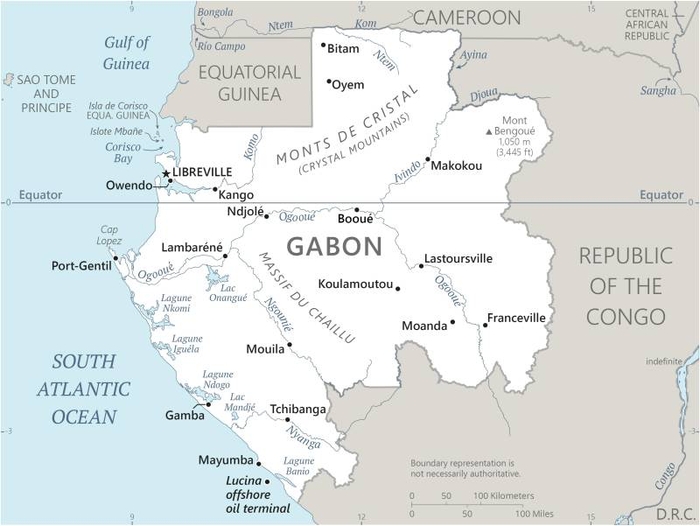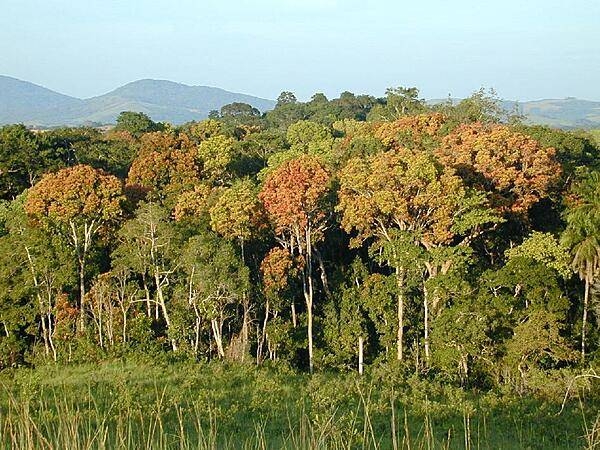197 Gabon

Three equal horizontal bands of green (top), yellow, and blue. Green represents the country’s forests and natural resources, gold represents the equator (which transects Gabon) as well as the sun, blue represents the sea.
Flag courtesy of the CIA World Factbook

Map courtesy of the CIA World Factbook

A view of some of the dense tropical forest in Gabon.
Photo courtesy of the CIA World Factbook
Government
According to Britannica, under the constitution of February 1961, which was in force for three decades, the Gabonese republic had an executive branch more powerful than the legislative and judicial branches. During the 1970s the constitution was amended to give the Gabonese Democratic Party (Parti Démocratique Gabonais; PDG), the only legal party after 1968, roles in the executive and legislative processes. In May 1990, following a national conference that was called in response to the upheaval of the previous four months, the constitution was amended to end the institutional role of the PDG and to restore a multiparty system. Parliamentary elections were held in September–October 1990, after which a new National Assembly adopted the constitution of March 1991; the constitution has since been amended.
Under the constitution the president, who is head of state, serves a seven-year term. The National Assembly has legislative powers, but the president has the authority to dissolve the National Assembly and postpone legislation. The president nominates the prime minister, who as head of the government selects the members of the Council of Ministers in consultation with the president. The president also has the power to remove the prime minister and council members from office. In practice most of the ministers are drawn from the 120 deputies in the National Assembly, which confirms the Council of Ministers and may oust the government through a vote of no confidence after a certain period.
The constitution provided for an upper legislative house (Senate) for the first time in the history of the republic, and the first elections to the Senate (indirect by local councils) were held in early 1997. A constitutional amendment passed by a PDG-dominated Assembly in April 1997 designated that the president of the Senate would succeed the president of the republic in case of the latter’s death or incapacity. The position of vice president of the republic was also created by amendment; the vice president, who cannot succeed the president, is appointed by and assists the president.
The 1991 constitution also provides strong guarantees for both individual and public liberties not found in the document of 1961. A Charter of Parties adopted at the same time as the constitution defines the role of Gabon’s political parties in a multiparty democracy.
Administratively, Gabon is divided into nine provinces, which are further divided into préfectures and sous-préfectures (subprefectures). Provincial governors, prefects, and subprefects are all appointed by the president.
The highest courts in Gabon’s judiciary system are the country’s former Supreme Court chambers: a judicial court, an administrative court, and a court of accounts, each with absolute authority over its area of expertise. Courts of appeal are found in Franceville and Libreville, and smaller tribunal courts exist throughout the country. There is also a constitutional court, which is the highest court with regards to constitutional matters. The judicial system includes customary law courts, presided over by traditional chiefs who mediate local disputes.
Gabonese National Civil Aviation Agency (ANAC)
The Gabonese National Civil Aviation Agency (ANAC) is a public establishment with national jurisdiction, endowed with technical and management autonomy, which was created by the Gabonese state by law 005/2008 of July 11, 2008 , thus replacing the General Secretariat for Civil and Commercial Aviation (SGACC), the first Gabonese Civil Aviation administration which had not undergone major changes since its creation in 1972.
This creation responded to a double concern: first, the concern of the Gabonese government to bring its civil aviation up to the standard of the ICAO, which recommends the transfer of the management of civil aviation to autonomous organizations like what is already done in several surrounding countries, then the inclusion of Gabon on the black list of the European Union, taking on board the observations of the ICAO.
Airspace
SkyVector – Google Maps – ADS-B Exchange
ICAO countries publish an Aeronautical Information Publication (AIP). This document is divided into three parts: General (GEN), En Route (ENR) and Aerodromes (AD). ENR 1.4 details the types of airspace classes they chose to adopt from classes A through G.
Drone Regulations
Gabonese Aeronautical Regulation No. 7
Drone activity declaration form
Advanced Air Mobility (AAM) Regulations & Policies
None found by the author.
However, should you, the reader, happen to stumble across something to the contrary, please email the author at FISHE5CA@erau.edu and you may be mentioned in the ACKNOWLEDGEMENTS section of this book by way of thanks for contributing to this free eBook!
Advanced Air Mobility (AAM) News
None found by the author.
However, should you, the reader, happen to stumble across something to the contrary, please email the author at FISHE5CA@erau.edu and you may be mentioned in the ACKNOWLEDGEMENTS section of this book by way of thanks for contributing to this free eBook!
Short Essay Questions
Scenario-Based Question
You have been hired by a Drone Startup Company. Your boss has immediately assigned this job to you.
They need you to prepare a one-page memo detailing the legalities of using a drone to locate missing tourists in the dense tropical forest, pictured above.
They need you to mention any national laws and local ordinances.
They specifically want to know what airspace (insert pictures) you will be operating in and whether or not you need an airspace authorization.
Does it matter whether or not you are a citizen of the country?
Lastly, there is a bonus for you if, as you scroll through this chapter, you find any typos or broken links!
Short Essay Questions
- What are the drone categories?
- How is registration addressed?
- How is remote ID addressed?
- What are the model aircraft rules?
- What are the commercial drone rules?
- Are there waivers or exemptions to the rules? If so, for what?
- Would you share a link to an interactive airspace map?
- How is BVLOS addressed?
- How can you fly drones at night?
- How can you fly drones over people?
- Where do you find drone NOTAMs?
- What are the rules for drone maintenance?
- What are the rules for an SMS program?
- What are some unique rules not mentioned above?
- What are the C-UAS rules?
- What are the AAM rules?

